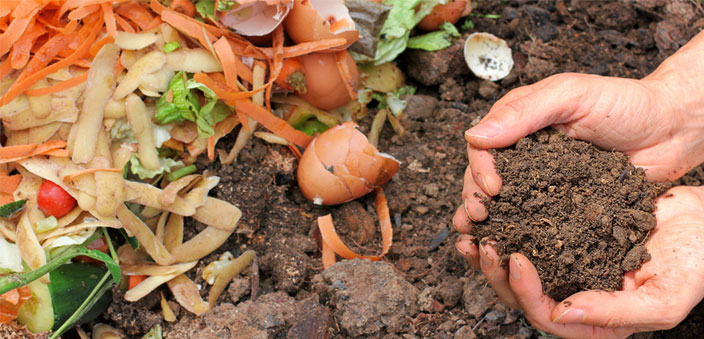Four flower pots in a row, all covered with a metal lid. This was the scene that caught my attention on the terrace. And I wondered what was going on. Then my neighbour Aparna strolled in, opened the lid of the last flower pot, dumped what looked like waste, piled soil on top of it and walked away. I was intrigued. Later I found out she was composting.
For the uninitiated, composting is a process of decomposition of organic substances in the presence of air, water and with the help of microbes. All organic matter from your kitchen can be decomposed, turned to rich soil and added to your garden. Composting is nature’s way of recycling organic matter. The end result is a soil, earthy in smell, and is nutrient dense that can be added to your plants. What a wonderful way to reduce our waste and give back to earth isn’t it?
So is the process complicated? I set about finding this with Aparna.
‘Once you understand the process, it is pretty simple,’ said Aparna by way of explanation. She uses flower pots that have adequate holes in them for composting. At the bottom of the pot she puts coconut husk and tops it with a layer of old soil. ‘I collect kitchen waste every day and bring them up to the terrace and dump them in the pot. I cover the waste with a layer of soil and close the pot. I do this every day. Twice a week I stir the waste and soil mix present in the pot, to ensure adequate aeration,’ she explains. Once the pot gets filled she uses a second pot, then a third and so on. ‘I generally need around three or four pots for my family of three’, she says.
Do remember to keep checking the contents of the pot regularly. If the compost is very dry then add in green waste like peels or vegetable scraps. If the compost is wet then make sure to add dry leaves or straw. A dish or a plate needs to be kept beneath each pot as well. Water from organic matter gets released during decomposition, and a dish is helpful to collect this water.
As the generation of compost takes around two months, this system works well for her. After about two months the compost is ready to use in the first pot. ‘The compost is neither too dry nor wet. It smells earthy and you feel wonderful handling it,’ she says quite contently. Her plants love this and her balcony boasts a number of veggies, not to mention seasonal flowers.
‘Composting has changed my life. Not only do I feel better that I do not contribute waste to landfills, but I am more connected to nature now,’ she says happily. Once she started generating compost it was easy for her to start growing vegetables and herbs. Today she is a happy gardener.
The process of composting
So what all can be composted?
The process followed above is a form of aerobic decomposition. This means composting happens in the presence of oxygen, and this method relies on adequate nitrogen, carbon, moisture and oxygen. If any of them is not in balance, the composting suffers. So let us see these things in detail.
Breaking down of organic matter which is a natural process, happens with the help of microbes. It requires carbon and nitrogen to compost. The carbon called as the browns is the dry leaves, straw, cardboard that we need to put in, and the nitrogen or the greens is the kitchen waste. The greens act as a protein source for the growth of the microbes while the browns are a source of energy. A good compost is formed when there is an equal mix of browns and greens. Less of greens implies the compost is too dry as the greens are the one with moisture in them, while less of browns indicates that the mixture is too wet.
To make composting easier several organisations have come up with products for home and garden composting. In Bangalore for example, the Daily Dump organisation offers products that comes with various kits like Small Khamba, Nano Khamba, Prithvi etc. Their Starter Kit comes with three pot units, small, large or nano size and a host of other things like a rake, microbes, remix powder, manual on composting etc., for easy composting. The tutorials on the website explain how to use the units. The remix powder that comes with the starter kits is mainly coco peat based and it is used to layer the kitchen waste. The addition of this powder ensures that the moisture content in the pile is just right, there is adequate aeration and there is no smell to attract fruit flies.
The trekking organisation that I worked with last year used another type of product called as Smart Bin from Green Tech Life. Here the composting was done anaerobically without the presence of air. Anaerobic composting releases gases like methane and hydrogen sulphide while the organic waste ferments. The advantage of the Smart Bin method is that you can dump food waste like meat. The liquid from the waste called the ‘smart brew’ can be collected as well.
The product comes with two bins, taps, strainers and a Bio Bloom powder that ensures no smell of the waste. It works in two stages. The organic waste is mixed with the microbial powder and added to the bin fitted with the strainer and taps. The powder ensures that the waste ferments without smell. The waste needs to be pressed thoroughly to cut off air. This is the first stage. Every two weeks the liquid from the waste can be collected from the taps. It can be diluted and added to plants or it can be used to unclog sinks. Once the bin is full it needs to be kept aside for sometime. In the second stage the pickled waste in the first bin is converted into compost. For detailed instructions on how to do this one can refer the videos on their website.
There is another type of composting using worms – red worms, earthworms etc. This is called vermicomposting. The nutrient content in vermin compost is dense as the worms consume the organic waste, enhance bacterial activity, and their excreta is rich in nitrate, making the soil very fertile. But this type of composting requires a bit of guidance as they require a conducive environment for their growth. Worms cannot tolerate a citric environment. Also, temperature needs to be moderated as they cannot tolerate warmer temperatures.
In India, 35 to 40 percent of the solid waste comprises organic matter. All this ends up in landfills along with dry waste like plastic, glass, metal etc. The organic matter decomposes anaerobically releasing greenhouse gases like methane. It also contaminates water and soil. By composting, you reduce your contribution to landfills. So act today. Go get a composter and start participating in building a greener earth.


 [/column]
[/column]